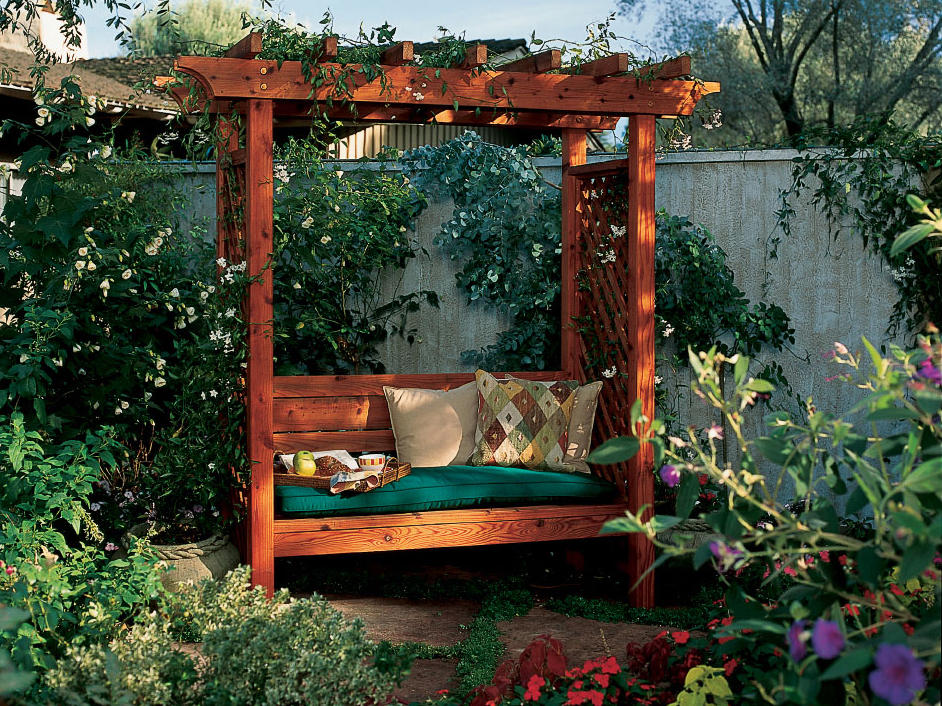
Garden Arbor Bench

You can add a little romance to your garden with this handsome arbor bench. The freestanding 60-inch-wide, 30-inch-deep, 86-inch-high structure has a number of subtle features that add to its appearance, strength, and comfort.
• No nails or screws show.
• Copper-pipe end caps mask countersunk carriage bolts.
• A deep seat and angled backrest stiffen the structure while providing comfort.
• Lattice side panels and overhead trellis train and support vines.
A person with average woodworking skills can build the project in a weekend. You can put it together in a workshop, then carry it assembled (with a few sturdy helpers) to its final destination. However, since it’s built in four main sections, it can also be broken down and reassembled on site.
The structure is broad and stable enough to stand on its own, but for a more permanent installation, you can anchor it to concrete footings with metal brackets embedded in them.
We built the bench with standard-dimension select-heart redwood, but you could substitute cedar, fir, or pressure-treated lumber; similarly, you could use a sturdy plastic lattice instead of redwood.
TIME: About 2 days
COST: About $300
Materials
• Lumber
• 4-by-4s: four 8-foot lengths
• 2-by-4s: one 8-foot length, four 10-foot lengths
• 1-by-1s: eight 8-foot lengths (or rip down from two 8-foot lengths of 1-by-6)
• 2-by-6s: six 8-foot lengths, two 10-foot lengths
• Two 2- by 8-foot redwood lattice panels
• 3 1/2-inch deck screws
• 2-inch galvanized finishing nails
• Six 2-by-4 joist hangers (with nails)
• 6 feet of undermount deck fastening brackets
• 30 1 1/4-inch deck screws (for seat)
• A dozen 21/2-inch screws
• Eight 5 1/2- by 3/8-inch carriage bolts
• Eight 3/8-inch washers
• 16 3/8-inch nuts
• Sandpaper
• Clear wood sealer
• Cotton rags
• 16 1-inch copper-pipe end caps
Tools
Most of the project requires basic woodworking tools–a circular saw, a saber saw, an electric drill, a hammer, and a nail set. You’ll need to rip a few boards into smaller sizes; you can use a table saw or ask the lumberyard to do it. You’ll also need:
• Tape measure
• Pencil
• Combination square
• Compass
• C-clamps or adjustable clamps
• Framing square
• 15/16-inch paddle bit
• Extra-long 1/2-inch drill bit
• Socket wrench set
• Ladder
• A small pump sprayer (about $10) to apply wood sealer (optional)
• Pipe clamps
DIRECTIONS
The arbor bench has four main sections: the two sides, the bench seat, and the backrest. Build it in the sequence that follows, allowing for the inevitable variation in the thickness of the lumber and lattice, which will affect widths and lengths. The trellis top, which consists of two pairs of horizontal 2-by-6s and seven 2-by-3 crosspieces, is added piece by piece. Before starting construction, rip two of the 8-foot 2-by-6s in half (to create 2-by-3s).
Assembling the side sections
1. Cut the 4-by-4s 84 inches long. To avoid splintering, bevel the bottom edges of each post.
2. Divide the posts into pairs and mark them (A and B, C and D). Lay each pair side by side on a flat work surface. Measuring from the bottom end, mark points at 6, 7 1/2, 70 1/2, and 72 inches. Using a pencil and combination square, draw lines at these points across the width of the posts. Set blade of circular saw to extend 1/4 inch and make multiple passes to remove the wood between the pairs of lines, creating grooves.
3. Measure actual width of lattice panels, add 1/2 inch to that dimension, then cut four 2-by-4 crosspieces to that size.
4. Turn pairs of posts so grooves face each other, place crosspieces in grooves, check squareness, and secure with two angled 31/2-inch deck screws.
5. Cut both lattice panels to fit between crosspieces, approximately 63 inches long.
6. Each lattice panel will be sandwiched between 1-by-1s mounted to the posts and crosspieces. Create the outer layer by cutting 1-by-1s to fit between posts and nail them to crosspieces flush to their outside edges. Cut and nail 1-by-1s to fit vertically between crosspieces. Place outer side face down on work surface. Insert lattice panel, then hold in place with 1-by-1s at top and bottom.
7. To complete sandwich, mark a point 17 inches from the bottom of each post. Measure, cut, and nail lengths of 1-by-1 that extend from the top crosspiece down to this point on either side of the lattice. (After seat is in place, cut and nail 1-by-1 to fit between seat and bottom crosspiece.)
The bench seat
The seat pieces are attached to a 5-foot-long ladder-like frame, which is held in place by deck screws that run through the frame and into the four posts. To make a snug fit, measure the distance between the posts and build the bench frame to that depth.
1. Equally space three 2-by-4 crosspieces between two 5-foot-long 2-by-4s and secure with joist hangers and nails.
2. Add undermount deck fastening brackets to top of each crosspiece.
3. Cut one 10-foot-long 2-by-4 and two 10-foot 2-by-6s into 5-foot lengths. Place on a work surface, alternating three 2-by-6s (save the fourth 2-by-6 for the back) with the two 2-by-4s. Position frame on top so the outer 2-by-6s are flush with the edge of the frame, equally space middle boards, and attach with 11/4-inch deck screws.
4. Stand the side panels on their back edges and slip in the bench so its top butts against the 1-by-1s on the inside faces of the posts. Check for squareness and drive two 31/2-inch deck screws through bench frame into each post.
The back
Slightly shorter than the bench, the back fits snugly between the two back posts. The actual size is determined after the bench seat is in place. The back is held together by screws running through a 12-inch 2-by-2 (ripped from a scrap of 2-by-4) at each end of its three boards.
1. After checking for squareness of the assembled sides and bench sections, measure the distance between the two rear posts. Cut two 2-by-4s and one 2-by-6 to this size.
2. Space the boards 1/8 inch apart, with ends flush. Overlay and attach the 2-by-2s, flush to the ends, with 21/2-inch screws. (Predrilling holes will avoid splitting the wood.) Round outside corners.
3. Stand the bench upright and recheck for squareness. Slip the back in place so the bottom board is 6 inches above the seat and the 2-by-2 backer boards are centered on the posts. Tack loosely in place with one screw through each 2-by-2 backer. Angle the back so it feels comfortable to lean against, then add another screw through each side. Set the screws firmly.
Adding the trellis
The top of the bench has two pairs of 2-by-6 beams connecting the posts and attached with countersunk carriage bolts. Seven 2-by-3s are spaced across the top.
1. Cut four 7-foot-long 2-by-6s. Using the compass, draw identical curving cutouts at the ends of each beam. Make cutouts with saber saw.
2. Lay the arbor bench on its back. Clamp a pair of the beams to the front and back of the front posts so they’re flush with the tops and extend equally on each side. Find center line of posts, transfer to top 2-by-6, and mark points 1 inch from top and bottom edges.
3. Drilling the holes through the beams and posts is the trickiest part of the whole project. When doing this step, it’s important to keep the drill perpendicular to the work surface. Use a square as a guide. Start drilling with the 15/16-inch paddle bit and make a 3/4-inch-deep hole at each of the four marked points. Switch to the long 1/2-inch bit and continue drilling through the top 2-by-6, the post, and almost through the bottom 2-by-6. Stop when bit begins to break through. Remove clamps and bottom 2-by-6. Switch back to a 15/16-inch bit and drill back into board (using break-through hole as a guide), making a 3/4-inch-deep hole.
4. Reposition and clamp boards, aligning them over the holes. Slip the carriage bolts through all the boards, add washers and double nuts, then tighten firmly with socket wrench.
5. Flip arbor bench on front face; repeat steps 2 through 4 for rear set of posts.
6. Cut seven 48-inch-long 2-by-3s.
7. While bench is still on its front, find center of beams and mark points, evenly spaced (approximately 9 inches apart), for the 2-by-3s.
8. Stand arbor upright. Place 2-by-3s at points marked so they extend equally to front and back. Secure with 31/2-inch deck screws.
Finishing touches
Sand all the wood surfaces except lattice. Transport structure to outside location (two strong people can do this, but three are better). Using a small pump sprayer – a life-saver with all that lattice – apply clear sealer to all surfaces. Wipe off excess sealer with cotton rags. When dry, apply second coat, following directions. The last step is to insert the copper-pipe end caps in the holes for the countersunk bolts. Depending on the fit, you may have to hammer or glue them in position.
RESOURCES
Undermount deck fastening brackets: Deckmaster (800/869-1375 or www.deckmaster.com); Shadoe Track (888/219-1700 or www.shadoetrack.com).
